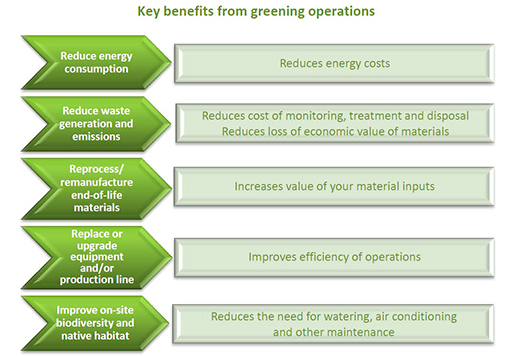Measuring the sustainability of operational processes
The company’s operational processes have a marked influence on its global environmental performances, hence the advantage in measuring sustainability.
The sustainability of activities implemented in order to transform factors of production into end products (operational processes) varies according to eight indicators:
- O1. Water intensity
- O2. Energy intensity
- O3. Renewable proportion of energy
- O4. Greenhouse gas intensity
- O5. Residuals intensity
- O6. Air releases intensity
- O7. Water releases intensity
- O8. Proportion of natural land
These are listed on the OECD website, where additional information can be found: OECD sustainable manufacturing indicators.
Calculation of operational processes indicators
In order to calculate these indicators, the company must first have data about its water and energy intensity and also about the sources that produce this energy. This information can be obtained from energy suppliers.
It is also necessary to know the residuals intensity, along with the quantity of greenhouse gas emissions released into the atmosphere. The residuals intensity can be measured directly. Greenhouse gas emissions have to be estimated based on energy consumption and sources. And lastly, data about the natural space occupied can be obtained from maps or satellite images.
The indicators are calculated using the following formula:
O1: Water intensity = Total water intake in m3 / Normalization factor
The indicator will fall as sustainability improves
O2: Energy intensity = Total energy intensity in megajoules / Normalization factor
The indicator will fall as sustainability improves
O3: Renewable proportion of energy consumed (in%) = Renewable energy consumed / Total energy consumed
x 100
The indicator will increase at the same time as sustainability
O4: Greenhouse gas intensity = (GHGs released in tons of CO2 / Normalization factor
The indicator will fall as sustainability improves
O5: Residuals intensity =
- (Weights of all inputs + Weight of fuel consumed – Weight of all products) / Normalization factor
Or
- Total weight in tons of all residuals / Normalization factor
The indicator will fall as sustainability improves
O6: Intensity of residual releases to air = Weight in tons of releases from production processes to air / Normalization factor
The indicator will fall as sustainability improves
O7: Intensity of pollutant releases to surface water = Weight in tons of releases from production processes to surface water / Normalization factor
The indicator will fall as sustainability improves
O8: Proportion (in %) of land occupied that is natural cover = Natural cover area / Total land area
The indicator will increase at the same time as sustainability
The information relating to normalization factors is available in the chapter entitled “Normalization of environmental performance indicators”.
Benefits generated by improved sustainability
Sustainable management of operational processes offers several primary advantages:
Source: OECD guidelines on sustainable manufacturing






